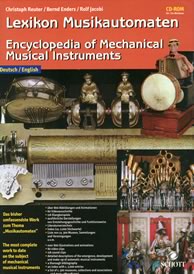Lexikon Musikautomaten, Die Welt der selbstspielenden Musikinstrumente [Encyclopedia of Mechanical Musical Instruments, The World of Self-playing Musical Instruments], ISBN 3-7957-6014-3, EAN 9783795760144, 2000, CD-ROM, available from Schott Musik International, Mainz, Germany; electronic mail musikautomaten@schott-musik.de; Web www.schott-music.com/musikautomaten.
Reviewed by Jim Hearon
San Francisco, California, USA
 The Lexikon
Musikautomaten CD-ROM, in German or English,
for Windows 95/98, requires a 486 or higher Wintel processor, a 4x
CD-ROM drive, 16-bit audio card, 16 MB RAM, a 640 x 480 graphics card
with 256 colors, and Video for Windows. It features over 800 illustrations
and animations, 60 video clips, 116 sound clips, a bibliography, an
index, a list of museums, and many other items.
The Lexikon
Musikautomaten CD-ROM, in German or English,
for Windows 95/98, requires a 486 or higher Wintel processor, a 4x
CD-ROM drive, 16-bit audio card, 16 MB RAM, a 640 x 480 graphics card
with 256 colors, and Video for Windows. It features over 800 illustrations
and animations, 60 video clips, 116 sound clips, a bibliography, an
index, a list of museums, and many other items.
Several people were involved in the creation of the disc: Christoph
Reuter—texts, graphics, audio and programming; Bernd Enders—concept,
organization, videos and support; Rolf Jacobi and Jürgen Hocker—photos,
material, contacts, insider advice and valuable information; and Stanley
Hanks—German-English translation.
The history of self-playing musical instruments begins with Archimedes in the 3rd century, B.C., and extends until the present day with references to modern technologies such as Digital Storage Mediums, the EPROM (Erasable Programmable Read Only Memory), and instruments such as the Bösendorfer SE computer-controlled piano, as well as various MIDI pianos. The CD-ROM user can easily learn about how technologies for self-playing instruments are related across the centuries, viewing such links as cylinders and peg mechanisms, piano-roll making or the DisKlavier. My favorite link to follow was learning about the history of mechanical violins from the first mechanical violins in 1849, to the Hupfeld Violina of 1907, to the mechanical violin interactive music theater Space Bodies by the violinist Mia Zabelka, where her playing is transmitted by sensors and cameras to a pneumatically-played violin controlled by a computer.
The history of Orchestrions is equally entertaining. These large, mechanical, indoor instruments attempted to emulate the sound of a whole orchestra largely through the use of flute pipes, strings, and percussion. They were manufactured commercially during the beginning of the 20th century by makers such as Phillips, Hupfeld, and Popper, and performed Classical and Romantic compositions by means of electric motors and piano rolls.
The CD-ROM stops short of including electronic musical instruments such as the synthesizer, instead concentrating on acoustic instruments for the most part. The overall approach also centers predominately upon European efforts; this may perhaps be due to the importance of the Augsburg musical clock industry from 1550-1650 in Bavaria, from which so many mechanical instruments ultimately developed.
An Index and Bibliography include an alphabetical list of sources along with a search engine for perusing the list, a complete list of executable audio examples, a similar list for video, and a complete alphabetized list of items on the CD-ROM for ease of use and quick navigation to particular items of interest.
A list of museums is included and is arranged interactively by country where one can find information for seeing existing self-playing musical instruments. Twenty-one countries are represented with information including location, viewing times, and in some cases, annotations on the nature of the exhibitions.
The included list of associations world-wide is quite large and is arranged by country, and comes with a search function as well. The Association List includes contact information, for example, on the Society of Self-Playing Musical Instruments in Germany, under Director Dr. Jürgen Hocker, in case one is interested in further pursuing the sources included on the Lexikon Musikautomaten CD-ROM.